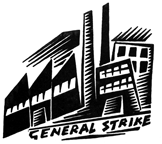Anarcho-syndicalism in the 20th Century—A new book from Black Cat Press
 We are happy to announce another new book from Black Cat Press. Anarcho-syndicalism in the 20th Century, translated by Malcolm Archibald, is now in stock. It’s heartening to see Vadim Damier’s book available to English-language readers. Recent titles, especially those utilizing so many archival sources, are expanding our understanding of the global anarchist movement.
We are happy to announce another new book from Black Cat Press. Anarcho-syndicalism in the 20th Century, translated by Malcolm Archibald, is now in stock. It’s heartening to see Vadim Damier’s book available to English-language readers. Recent titles, especially those utilizing so many archival sources, are expanding our understanding of the global anarchist movement.
We welcome the opportunity to reflect on the recent history of a movement that is often dubbed moribund, outmoded, or otherwise useless. What’s perhaps strangest about the blanket rejection of the syndicalist tradition is that it is often done with such ignorance. Hopefully resources like this one by Damier will change the perceptions of some contemporary anarchists toward the anarcho-syndicalist legacy. Although, more importantly, may the book embolden those drawing lessons from the global anarchist tradition to apply them in the here and now, under present circumstances.
Here’s an excerpt (and a photo of Vadim):
 Preface
Preface
Anarcho-syndicalism is a fundamental tendency in the global workers’ movement. It is made up of revolutionary unions of workers (“syndicat” in French means “trade union”), acting to bring about a stateless (anarchist), self-managed society.
Anarcho-syndicalism, the only mass variant of the anarchist movement in history, arose and acquired strength during a period of profound social, economic, and political changes—the first decades of the 20th century. In the countries which formed the “centre” of the global industrial-capitalist system, a transition to a developed industrial society was taking place, while on the “periphery” and “semi-periphery” the process of industrialization was still only getting started. The furious pace of social change often caused much suffering for the workers, forcing them to abandon traditional occupations and forms of life and pushing them into factories, frequently under onerous conditions. Former agricultural labourers were uprooted from their accustomed mode of life—conditioned by centuries—while skilled craftsmen experienced anguish when they were forced into narrowly specialized or unskilled work. The workers’ consciousness was scarred by the growing alienation and atomization of the human personality under the conditions of the rise of “mass society.”
The workers’ movement arose, to a significant extent, as an alternative force in relation to the industrial-capitalist system. As the Italian sociologist Marco Revelli has noted, “the modern State from the very beginning counterposed these two forces to each other, as opposing tendencies.” Of course, this opposition could be regarded in different ways, either more radically (as in the case of the English Luddites who resisted the introduction of the factory system), or less radically (in the form of workers’ mutual aid societies, taking upon themselves control of the social sphere). But almost always this “early” workers’ movement was based on the spirit of independence, communal life, and collectivism preserved from the pre-industrial era of artisan workshops, in opposition to factory despotism. The division of labour had still not reached the level of Taylorist fragmentation. Skilled workers, with a good understanding of their own work and where it fit in the production process, were quite capable of thinking they could control production on their own. On the other hand, the State mechanisms of social integration had not yet achieved sufficient development; rather the social sphere was almost completely controlled by the institutions and organizations of the workers’ movement (associations, syndicates, bourses de travail, etc.), which frequently were regarded as the basis for a possible self-managed alternative.
In the social realities of those times there was undeniably a place for radical tendencies which to some degree aimed at the dismantling, elimination, or radical transformation of the industrial-capitalist system. Although the majority of revolutionary syndicalists and anarchists were by no means immune from certain myths and concepts about the progressiveness of industrialism, still their social goals on the whole were oriented to a rupture with the system and its replacement with a new social structure based on self-management and decision-making by means of agreements arrived at “from the bottom up.” Such views were compatible in many respects with the desires of the working masses in that epoch.
It is impossible to regard anarcho-syndicalism as some kind of insignificant, marginal phenomenon—as the extravagant escapades of “extremist grouplets” or the fantasies of salon intellectuals. This is a global movement which spread to countries as different as Spain and Russia, France and Japan, Argentina and Sweden, Italy and China, Portugal and Germany. It possesses strong, healthy social roots and traditions, and was able to attract hundreds of thousands, indeed millions, of wage workers. Anarcho-syndicalists not only took an active part in the most important social upheavals and conflicts of the 20th century, often leaving their own indelible imprint on these events, but also in many countries they formed the centre of a special, inimitable, working class culture with its own values, norms, customs, and symbols. The ideas and traditions of anarcho-syndicalism, and the slogans it put forth about workplace and territorial self-management, exerted an influence on many other social movements, including the workers’ councils of Budapest (1956), the student and youth uprisings of 1968, Polish “Solidarity” in 1980–81, the Argentine “popular assemblies,” etc.
Without knowing the history of anarcho-syndicalism, it is impossible to gain a reliable understanding of the history of many countries of the world; it is impossible to grasp in its fullness the course of development and destiny of humanity throughout the last 120 years…
V. Damier
TABLE OF Contents
 PART ONE Revolutionary Syndicalism
PART ONE Revolutionary Syndicalism
From the First International to Revolutionary-Syndicalism
The Rise of the Revolutionary-Syndicalist Movement
Revolutionary-Syndicalism and Anarchism
Revolutionary-Syndicalism during the First World War
PART TWO Anarcho-syndicalism
The Revolutionary Years
From Revolutionary-Syndicalism to Anarcho-syndicalism
The World Anarcho-syndicalist Movement in the 1920’s and 1930’s
Ideological-Theoretical Discussions in Anarcho-syndicalism in the 1920’s and 1930’s
PART THREE The Spanish Revolution
The Uprising of July 19 1936
Libertarian Communism or Antifascist Unity?
Under the Weight of Circumstances
The CNT Enters the Government
The CNT in Government: Results and Lessons
Notwithstanding “Circumstances”
The Spanish Revolution and World Anarcho-syndicalism
PART FOUR Decline and Possible Regeneration
Anarcho-syndicalism During the Second World War
Anarcho-syndicalism After World War II
Anarcho-syndicalism in Russia in the Current Epoch
Bibliographic Essay
Acronyms
Index
